Eskom Hld SOC Ltd or Eskom (Afrikaans: Elektrisiteitsvoorsieningskommissie) is a South African electricity public utility. Eskom was established in 1923 as the Electricity Supply Commission (ESCOM). Eskom represents South Africa in the Southern African Power Pool. The utility is the largest producer of electricity in Africa, and was among the top utilities in the world in terms of generation capacity and sales. It is the largest of South Africa's state owned enterprises. Eskom operates a number of notable power stations, including Matimba Power Station and Medupi Power Station in Lephalale, Kusile Power Station in Witbank, Kendal Power Station, and Koeberg Nuclear Power Station in the Western Cape Province, the only nuclear power plant in Africa.
Colenso is a town in KwaZulu-Natal, South Africa. It is located on the southern bank of the Tugela River on the R103 road. The original settlement was contained within a loop on the river, but it subsequently expanded southwards and eastwards. It lies on the main Durban - Johannesburg railway line some 190 km (118 mi) north-west of Durban.
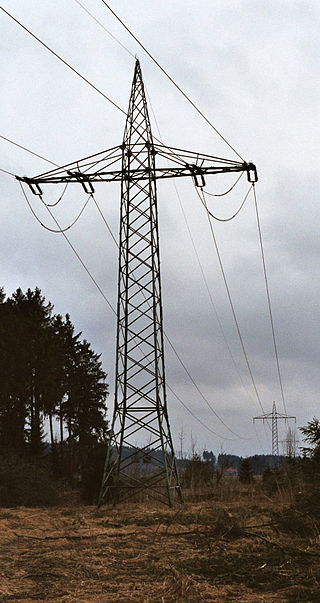
A traction network or traction power network is an electricity grid for the supply of electrified rail networks. The installation of a separate traction network generally is done only if the railway in question uses alternating current (AC) with a frequency lower than that of the national grid, such as in Germany, Austria and Switzerland.

The South African Railways Class GL 4-8-2+2-8-4 of 1929 was an articulated steam locomotive.

Dunston Power Station refers to a pair of adjacent coal-fired power stations in the North East of England, now demolished. They were built on the south bank of the River Tyne, in the western outskirts of Dunston in Gateshead. The two stations were built on a site which is now occupied by the MetroCentre. The first power station built on the site was known as Dunston A Power Station, and the second, which gradually replaced it between 1933 and 1950, was known as Dunston B Power Station. The A Station was, in its time, one of the largest in the country, and as well as burning coal had early open cycle gas turbine units. The B Station was the first of a new power station design, and stood as a landmark on the Tyne for over 50 years. From the A Station's opening in 1910 until the B Station's demolition in 1986, they collectively operated from the early days of electricity generation in the United Kingdom, through the industry's nationalisation, and until a decade before its privatisation.

When the Second Boer War broke out on 11 October 1899, the Boers had a numeric superiority within Southern Africa. They quickly invaded the British territory and laid siege to Ladysmith, Kimberley and Mafeking. Britain meanwhile transported thousands of troops both from the United Kingdom itself and from elsewhere in the Empire and by the time the siege of Ladysmith had been lifted, had a huge numeric superiority.
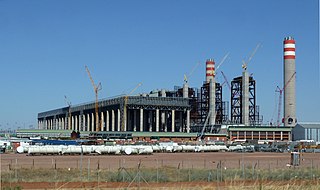
Medupi Power Station is a dry-cooled coal-fired power station built by Eskom near Lephalale in Limpopo province, South Africa. The station consists of 6 generating units with a nameplate capacity of 800 MW each bringing the total installed capacity of 4,800 MW.
Acton Lane Power Station was a power station in London NW10. The station, also known as Willesden power station, was located to the south of the Euston to Birmingham railway on a site bounded by Acton Lane, the Grand Union Canal and the Dudding Hill railway line. In later years the site was extended to the south side of the canal. The entire site is now occupied by Willesden Grid Supply Point buildings.
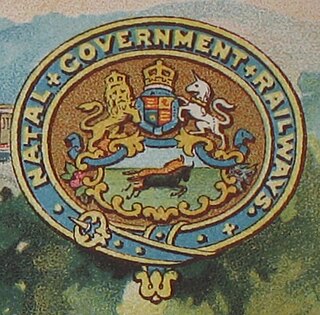
The Natal Government Railways (NGR) was formed in January 1877 in the Colony of Natal.
Majuba Power Station between Volksrust and Amersfoort in Mpumalanga, South Africa, is a coal-fired power plant operated by Eskom. Majuba is Eskom's only power station that is not linked to a specific mine and it receives its coal from various sources. This was due to an error during Apartheid times in geotechnical engineering core drilling which did not identify that the proposed local coal mine was under solid bedrock.
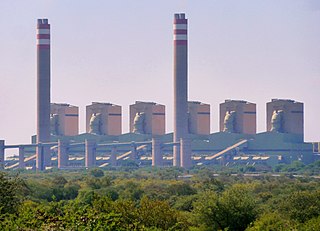
Matimba Power Station close to Ellisras, Limpopo Province, South Africa, is a dry-cooled coal-fired power plant operated by Eskom.

The South African Railways Class 1E of 1925 was an electric locomotive.
South Africa has a large energy sector, being the third-largest economy in Africa. The country consumed 227 TWh of electricity in 2018. The vast majority of South Africa's electricity was produced from coal, with the fuel responsible for 88% of production in 2017. South Africa is the 7th largest coal producer in the world. As of July 2018, South Africa had a coal power generation capacity of 39 gigawatts (GW). South Africa is the world's 14th largest emitter of greenhouse gases. South Africa is planning to shift away from coal in the electricity sector and the country produces the most solar and wind energy by terawatt-hours in Africa. The country aims to decommission 34 GW of coal-fired power capacity by 2050. It also aims to build at least 20 GW of renewable power generation capacity by 2030. South Africa aims to generate 77,834 megawatts (MW) of electricity by 2030, with new capacity coming significantly from renewable sources to meet emission reduction targets. Through its goals stated in the Integrated Resource Plan, it announced the Renewable Energy Independent Power Producer Procurement Programme, which aims to increase renewable power generation through private sector investment.

The provision of electricity in Queensland required a considerable degree of pioneering, innovation, and commitment. Queensland proved to be a pioneer in the supply of electricity in Australia, with the first public demonstration in Australia, the first recorded use for public purposes in the country, the first Parliament House in Australia and the first commercial operations in Australia all occurring in Brisbane.
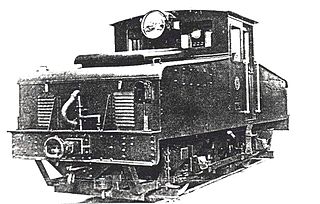
The South African Railways Class ES1 of 1924 was an electric locomotive.

The Electricity sector in South Africa is an important part of energy in South Africa. Most power stations in South Africa are owned and operated by the state owned enterprise, Eskom. These plants account for 80% of all the electricity produced in South Africa and 45% of all electricity produced on the African continent.
Burning of charcoal and wood fuel provides approximately 94 percent of the energy in Malawi. Much of the renewable hydroelectric potential of the country is untapped. As per 2018 Population and Housing Census, the national electrification rate in Malawi was 10%, with 37% of the urban population and only 2% of the rural population having access to electricity.
Carlisle power stations were two electricity generating stations that supplied electricity to Carlisle and the surrounding area from 1899 until 1980. The first power station (1899–1927) was in the centre of the city near Nelson Bridge, and the second larger station was at Willow Holme North-West of the city (1923–1980).
Victoria Falls and Transvaal Power Company was a South African-based electricity company that supplied power to the goldmines and industry on the Witwatersrand. It was a Southern Rhodesian registered company whose main facilities were based in the Transvaal, South Africa. It was formed in 1906 and would supply power in its own name and on behalf of Eskom until 1948 when it was expropriated by the former.












